

EDUCATIONAL INSIGHT
14 Questions People Ask About Hinduism
…and 14 tweetable answers!
_______________
Humanity’s most profound faith is now a global phenomenon. Students, teachers, neighbors and friends are full of questions about cow worship, cremation, caste, many Gods, karma, reincarnation, idols, yoga & more. Here are fourteen answers you can use to set the record straight.
_______________

DINODIA
A visitor to India questions an elder about temple ceremonies and various Hindu customs
HAVE YOU EVER BEEN PUT ON the spot with a provocative question about Hinduism, even one that really shouldn’t be so hard to answer? If so, you are not alone. It takes some good preparation and a little attitude adjustment to confidently field queries on your faith—be they from friendly co-workers, students, passersby or especially from Christian evangelists. Back in the spring of 1990, a group of teens from the Hindu Temple of Greater Chicago, Lemont, sent a request to HINDUISM TODAY for “official answers” to nine questions they were commonly asked by their peers. These questions had perplexed the Hindu youth themselves, and their parents had no convincing answers. Satguru Sivaya Subramuniyaswami took up the challenge and provided the following answers to the nine questions. We have since added five more questions, including a dialog on caste, since that is the most relentless criticism Hinduism faces today.
Let’s begin with advice on the attitudes to hold when responding. First, ask yourself, “Who is asking the question?” Millions of people are sincerely interested in Hinduism and the many Asian religions. So, when asked about Hinduism, don’t be defensive, even if the questioner seems confrontational. Instead, assume that the person really wants to learn. Of course, some only want to harass, badger and turn you to their view. If you sense this is the case, feel free to smile and courteously dismiss yourself without any attempt to answer, lest you simply add fuel to his fires.
Bearing this in mind, it is still best never to answer a question about religion too boldly or too immediately. That might lead to confrontation. Offer a prologue first, then come to the question, guiding the inquirer toward understanding. Your poise and deliberateness gives assurance that you know what you are talking about. It also gives you a moment to think and draw on your intuitive knowing. Before going deeply into an answer, always ask the questioner what his religion is. Knowing that, you can address his particular frame of mind and make your answer most relevant. Another key: have confidence in yourself and your ability to give a meaningful and polite response. Even to say “I am sorry. I still have much to learn about my religion and I don’t yet know the answer to that” is a meaningful answer. Honesty is always appreciated. Never be afraid to admit what you don’t know, for this lends credibility to what you do know.
Here are four prologues that can be used, according to the situation, before you begin to actually answer a question. 1) “I am really pleased that you are interested in my religion. You may not know that one out of every six people in the world is a Hindu.” 2) “Many people have asked me about my tradition. I don’t know everything, but I will try to answer your question.” 3) “First, you should know that in Hinduism, it is not only belief and intellectual understanding that is important. Hindus place the greatest value on experiencing each of these truths personally.” 4) The fourth type of prologue is to repeat the question to see if the person has actually stated what he wants to know. Repeat the question in your own words and ask if you have understood his query correctly. If it’s a complicated question, you might begin by saying, “Philosophers have spent lifetimes discussing and pondering questions such as this, but I will do my best to explain.”
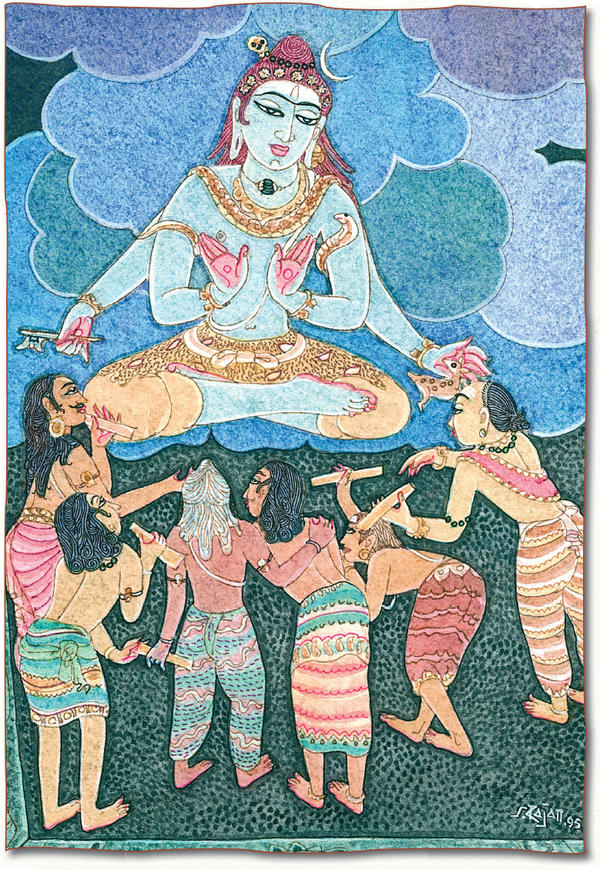
S. RAJAM
A. MANIVEL
Lord Siva sits in His world of light, approached by petitioners who have scribed questions on palm leaves, as in the days of yore
Have courage. Speak from your inner mind. Sanatana Dharma is an experiential path, not a dogma, so your experience in answering questions will help your own spiritual unfoldment. You will learn from your answers if you listen to your inner mind speak. This can actually be a lot of fun. The attentive teacher always learns more than the student.
After the prologue, address the question without hesitation. If the person is sincere, you can ask, “Do you have any other questions?” If he wants to know more, then elaborate as best you can. Use easy, everyday examples. Share what enlightened souls and scriptures of Hinduism have said on the subject. Remember, we must not assume that someone who asks about Hinduism is insincere or is challenging our faith. Many are just being friendly or making conversation to get to know you; others, having reincarnated into a strange culture, are searching for the way back “home.” So don’t be on the defensive or take it all too seriously. Smile when you give your response. Be open. If the second or third question is on something you know nothing about, you can say, “I don’t know. But if you’d like, I will find out and email you what I find out.” Smile and have confidence as you give these answers. Don’t be shy. Your birth karmas ensure that nobody can ask you a question to which you are unable to provide a fine answer that will fully satisfy the seeker. You may make lifelong friends in this way.
In the following pages, each question is addressed by a short response that can be committed to memory, a longer answer, and a detailed explanation. Many questioners will be content with the short, simple answer, so start with that first. Use the explanation as background information for yourself, or as a contingency response in case you end up in a deeper philosophical discussion.
To order additional copies of this Educational Insight and other Hindu literature, email: pamphlets@hindu.org. Additional resources can be found at: www.hinduismtoday.com/category/hindu-basics/.
1
Why does Hinduism have so many Gods?
Hindus all believe in one Supreme God who created the universe. He is all-pervasive. He created many Gods, highly advanced spiritual beings, to be His helpers.
CONTRARY TO PREVAILING MISCONCEPTIONS, HINDUS ALL worship a one Supreme Being, though by different names. This is because the peoples of India with different languages and cultures have understood the one God in their own distinct way. Through history there arose four principal Hindu denominations—Saivism, Shaktism, Vaishnavism and Smartism. For Saivites, God is Siva. For Shaktas, Goddess Shakti is supreme. For Vaishnavites, Lord Vishnu is God. For Smartas—who see all Deities as reflections of the One God—the choice of Deity is left to the devotee. This liberal Smarta perspective is well known, but it is not the prevailing Hindu view. Due to this diversity, Hindus are profoundly tolerant of other religions, respecting the fact that each has its own pathway to the one God.
One of the unique understandings in Hinduism is that God is not far away, living in a remote heaven, but is inside each and every soul, in the heart and consciousness, waiting to be discovered. This knowing that God is always with us gives us hope and courage. Knowing the One Great God in this intimate and experiential way is the goal of Hindu spirituality.
Elaboration: Hinduism is both monotheistic and henotheistic. Hindus were never polytheistic, in the sense that there are many equal Gods. Henotheism (literally “one God”) better defines the Hindu view. It means the worship of one God without denying the existence of other Gods. We Hindus believe in the one all-pervasive God who energizes the entire universe. We can see Him in the life shining out of the eyes of humans and all creatures. This view of God as existing in and giving life to all things is called panentheism. It is different from pantheism, which is the belief that God is the natural universe and nothing more. It is also different from strict theism which says God is only above the world, apart and transcendent. Panentheism is an all-encompassing concept. It says that God is both in the world and beyond it, both immanent and transcendent. That is the highest Hindu view.
Hindus also believe in many Gods who perform various functions, like executives in a large corporation. These should not be confused with the Supreme God. These Divinities are highly advanced beings who have specific duties and powers—not unlike the heavenly spirits, overlords or archangels revered in other faiths. Each denomination worships the Supreme God and its own pantheon of divine beings.
What is sometimes confusing to non-Hindus is that Hindus of various sects may call the one God by many different names, according to their denomination or regional tradition. Truth for the Hindu has many names, but that does not make for many truths. Hinduism gives us the freedom to approach God in our own way, encouraging a multiplicity of paths, not asking for conformity to just one.
There is much confusion about this subject, even among Hindus. Learn the right terms and the subtle differences in them, and you can explain the profound ways Hindus look at Divinity. Others will be delighted with the richness of the Indian concepts of God. You may wish to mention that some Hindus believe only in the formless Absolute Reality as God; others believe in God as personal Lord and Creator. This freedom makes the understanding of God in Hinduism, the oldest living religion, the richest in all of Earth’s existing faiths.
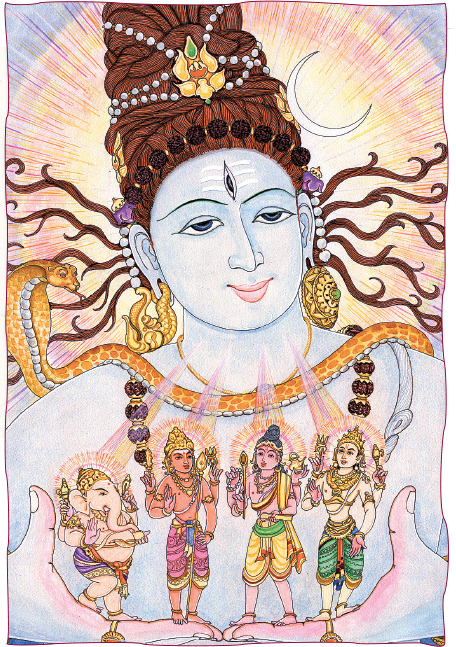
A. MANIVEL
Hindus all worship the One Supreme God, called by various names, depending on their denomination. They also revere a multitude of angelic beings, which they call Gods. Above, the central figure is Lord Siva, worshiped as the Supreme Being by Saivites and many other Hindus. Cradled in His hands are other great beings, known as Gods, including Lord Ganesha.
2
Do Hindus believe in reincarnation?
Yes, we believe the soul is immortal and takes birth time and time again. Through this process, we have experiences, learn lessons and evolve spiritually. Finally we graduate from physical birth.
CARNATE MEANS “OF FLESH,” AND reincarnate MEANS TO “reenter the flesh.” Yes, Hindus believe in reincarnation. To us, it explains the natural way the soul evolves from immaturity to spiritual illumination. Life and death are realities for all of us. Hinduism believes that the soul is immortal, that it never dies, but inhabits one body after another on the Earth during its evolutionary journey. Like the caterpillar’s transformation into a butterfly, physical death is a most natural transition for the soul, which survives and, guided by karma, continues its long pilgrimage until it is one with God.
I myself have had many lives before this one and expect to have more. Finally, when I have it all worked out and all the lessons have been learned, I will attain enlightenment and moksha, liberation. This means I will still exist, but will no longer be pulled back to be born in a physical body.
Even modern science is discovering reincarnation. There have been many cases of individuals’ remembering their past lives. These have been researched by scientists, psychiatrists and parapsychologists during the past decades and documented in good books and videos. Young children speak of vivid past-life memories, which fade as they grow older, as the veils of individuality shroud the soul’s intuitive understanding. Great mystics speak of their past lives as well. So do our ancient scriptures, the Vedas, reveal the reality of reincarnation.
Reincarnation is believed in by the Jains and the Sikhs, by the Indians of the Americas, and by the Buddhists, certain Jewish sects, the Pagans and the many indigenous faiths. Even Christianity originally taught reincarnation, but formally renounced it in the twelfth century. It is, in fact, one of the most widely held articles of faith on planet Earth.
Elaboration: At death the soul leaves the physical body. But the soul does not die. It lives on in a subtle body called the astral body. The astral body exists in the nonphysical dimension called the astral plane, which is also the world we are in during our dreams at night when we sleep. Here we continue to have experiences until we are reborn again in another physical body as a baby. Each reincarnating soul chooses a home and a family which can best fulfill its next step of learning and maturation.
After many lifetimes of following dharma, the soul is fully matured in love, wisdom and knowledge of God. There is no longer a need for physical birth, for all lessons have been learned, all karmas fulfilled. That soul is then liberated, freed from the cycle of birth, death and rebirth. Evolution then continues in the more refined spiritual worlds.
Similarly, after we graduate from elementary school we never have to go back to the fifth grade. We have gone beyond that level in understanding. Thus, life’s ultimate goal is not money, not clothes, not sex, not power, not food or any other of the instinctive needs. These are natural pursuits, but our real purpose on this Earth is to know, to love and to serve God and the Gods. That leads to the rare and priceless objects of life: enlightenment and liberation. This Hindu view of the soul’s evolution answers many otherwise bewildering questions, removing the fear of death while giving assurance that each soul is evolving toward the same spiritual destiny, for the Hindu believes that karma and reincarnation are leading every single soul to God Realization.
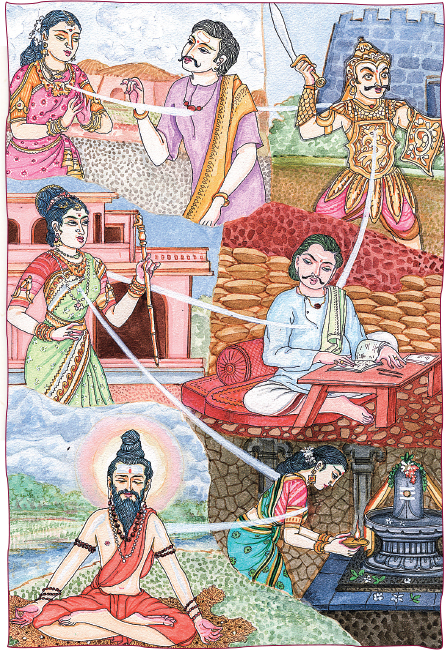
A. MANIVEL
Each soul evolves by experiencing many varied lives through reincarnation, called punarjanma in Sanskrit, the process wherein the soul repeatedly takes on a physical body through being born on Earth. Here, a soul, represented by the ray of light, is shown in seven successive lives. Reincarnation is a purposeful maturing process governed by the law of karma.
3
What is karma?
Karma is the universal principle of cause and effect. Our actions, both good and bad, come back to us in the future, helping us to learn from life’s lessons and become better people.
KARMA IS ONE OF THE NATURAL LAWS OF THE MIND, JUST AS gravity is a law of matter. Just as God created gravity to bring order to the physical world, He created karma as a divine system of justice that is self-governing and infinitely fair. It automatically creates the appropriate future experience in response to the current action. Karma simply means “action” or “cause and effect.” When something happens to us that is apparently unfortunate or unjust, it is not God punishing us. It is the result of our own past actions.
The Vedas, Hinduism’s revealed scripture, tell us if we sow goodness, we will reap goodness; if we sow evil, we will reap evil. Thus we create our own destiny through thought and action. And the divine law is: whatever karma we are experiencing in our life is just what we need at the moment, and nothing can happen but that we have the strength to meet it. Even harsh karma, when faced in wisdom, can be the greatest catalyst for spiritual growth. Understanding the way karma works, we seek to live a good and virtuous life through right thought, right speech and right action. This is called dharma.
Elaboration: Karma is basically energy. I throw energy out through thoughts, words and deeds, and it comes back to me, in time, through other people. Karma is our best teacher, for we must always face the consequences of our actions and thus improve and refine our behavior, or suffer if we do not. We Hindus look at time as a circle, as things cycle around again. Professor Einstein came to the same conclusion. He saw time as a curve, and space as well. This would eventually make a circle.
Karma is a very just law which, like gravity, treats everyone the same. Because we Hindus understand karma, we do not hate or resent people who do us harm. We understand they are giving back the effects of the causes we set in motion at an earlier time. The law of karma puts man at the center of responsibility for everything he does and everything that is done to him.
Karma is a word we hear quite often on television. “This is my karma,” or “It must have been something I did in a past life to bring such good karma to me.” We hear karma simply defined as “What goes around, comes around.” In some schools of Hinduism, karma is looked upon as something bad—perhaps because we are most aware of this law when we are facing difficult karma, and not so aware of it when life is going smoothly. Some Hindus even equate karma with sin, and this is what evangelical Christians preach that it means. Many people believe that karma means “fate,” a preordained destiny over which one has no control, which is also untrue.
The process of action and reaction on all levels—physical, mental and spiritual—is karma. Here is an example. I say kind words to you, and you feel peaceful and happy. I say harsh words to you, and you become ruffled and upset. The kindness and the harshness will return to me, through others, at a later time. This is karma. An architect thinks creative, productive thoughts while drawing plans for a new building. But were he to think destructive, unproductive thoughts, he would soon not be able to accomplish any kind of positive task even if he desired to do so. This is karma, a natural law of the mind. We must also be very careful about our thoughts, because thought creates, and thoughts make karmas—good, bad and mixed.
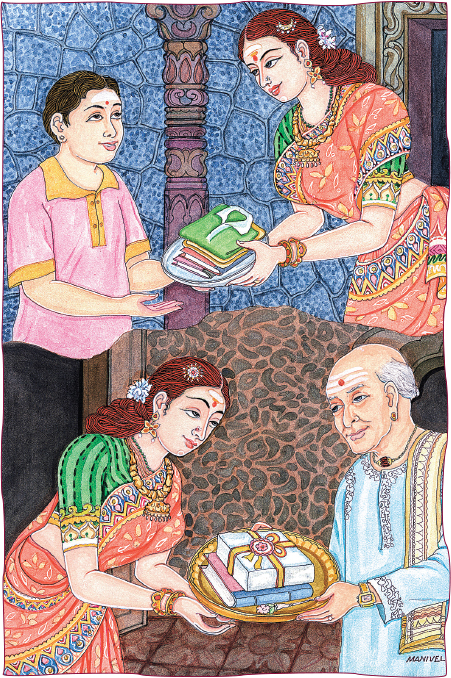
A. MANIVEL
One of the best examples of karma is that you can’t give anything away but that generosity will return to you, with interest. Here, in the upper scene, a lady gives clothing to a youth. Below, she receives an unexpected gift from a neighbor as the karma of her good deed brings its natural reward. By wisely heeding karma’s ways, we tread the path of dharma.
4
Why do Hindus worship the cow?
Hindus don’t worship cows. We respect, honor and adore the cow. By honoring this gentle animal, who gives more than she takes, we honor all creatures.
HINDUS REGARD ALL LIVING CREATURES AS SACRED—MAMmals, fishes, birds and more. We acknowledge this reverence for life in our special affection for the cow. At festivals we decorate and honor her, but we do not worship her in the sense that we worship the Deity.
To the Hindu, the cow symbolizes all other creatures. The cow is a symbol of the Earth, the nourisher, the ever-giving, undemanding provider. The cow represents life and the sustenance of life, providing manure for fertilizers and fuel for fires. The cow is so generous, taking nothing but water, grass and grain. It gives and gives and gives of its milk, as does the liberated soul give of his spiritual knowledge. The cow is so vital to life, the virtual sustainer of life, for many humans. The cow is a symbol of grace and abundance. Veneration of the cow instills in Hindus the virtues of gentleness, receptivity and connectedness with nature.
Elaboration: We are all aware of the remarkable value of the cow, how she provides milk and cream, yogurt and cheese, butter and ice cream, ghee and buttermilk. It would be hard to imagine the human diet without her gifts.
Mahatma Gandhi once said, “One can measure the greatness of a nation and its moral progress by the way it treats its animals. Cow protection to me is not mere protection of the cow. It means protection of all that lives and is helpless and weak in the world. The cow means the entire subhuman world.” The only cow question for Hindus is, “Why don’t more people respect and protect this remarkable creature?”
In the Hindu tradition, the cow is honored, garlanded and given special feedings at festivals all over India, most importantly the annual Gopashtami festival. Demonstrating how dearly Hindus love their cows, colorful cow jewelry and clothing is sold at fairs all over the Indian countryside. From a young age, Hindu children are taught to decorate the cow with garlands, paint and ornaments. Her nature is epitomized in Kamadhenu, the divine, wish-fulfilling cow. The cow and her sacred gifts—milk and ghee in particular—are essential elements in Hindu worship, penance and rites of passage. In India, more than 3,000 institutions called Gaushalas, maintained by charitable trusts, care for cows, especially the homeless ones. And while many Hindus are not vegetarians, most respect the still widely held code of abstaining from eating beef.
The Indian cow, Bos indicus, or Zebu, is regarded by her admirers as more a deva than a beast. The species is unique in both temperament and conformation. She boasts a large fatty hump at the shoulders, drooping ears, a pendulous fleshy dewlap at the throat and a special shape to the rump. Additionally, experts will point out a long streak down the spine, which is light in dark cows and dark in lighter ones. The Zebu, like the Jersey, gives a special form of milk, called A2, that is ideally suited to human consumption and health.
By her docile, tolerant nature, the cow exemplifies the cardinal virtue of Hinduism, noninjury, or ahimsa. The cow also symbolizes dignity, strength, endurance, maternity and selfless service. In the Vedas, cows represent wealth and joyous Earthly life. From the Rig Veda (4.28.1;6) we read, “The cows have come and have brought us good fortune. In our stalls, contented, may they stay! May they bring forth calves for us, many-colored, giving milk for Indra each day. You make, O cows, the thin man sleek; to the unlovely you bring beauty. Rejoice our homestead with pleasant lowing. In our assemblies we laud your vigor.”
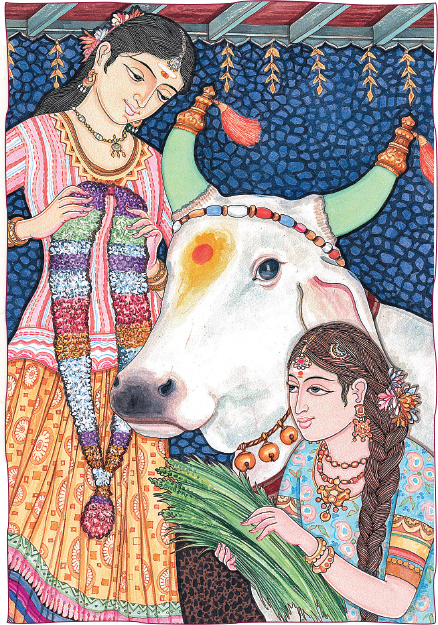
A. MANIVEL
Hindus do not worship cows, but they do revere them as the perfect example of Divinity in all forms of life. Here a girl garlands a cow whose horns are painted and adorned with brass tips and tassels. Her sister offers fresh grass. In India, the cow is honored, adored and protected as a symbol of wealth, strength, abundance, selfless giving and a full Earthly life.
5
Are Hindus idol worshipers?
Hindus do not worship a stone or metal “idol” as God. We worship God through the image. We invoke the presence of God from the higher, unseen worlds, into the image so that we can commune with Him and receive His blessings.
THE STONE OR METAL DEITY IMAGES IN HINDU TEMPLES AND shrines are not mere symbols of the Gods. They are the form through which their love, power and blessings flood forth into this world. We may liken this mystery to our ability to communicate with others through the telephone. We do not talk to the telephone; rather we use it as a means of communication with another person. Without the telephone, we could not converse across long distances; and without the sanctified icon in the temple, we cannot easily commune with the Deity.
Divinity can also be invoked and felt in a sacred fire, or in a tree, or in the enlightened person of a satguru. In our temples, God is invoked in the sanctum by highly trained priests. Through the practice of yoga, or meditation, we invoke God inside ourself. Yoga means to yoke oneself to God within. The image or icon of worship is a focus for our prayers and devotions.
Another way to explain icon worship is to acknowledge that Hindus believe God is everywhere, in all things, whether stone, wood, creatures or people. So, it is not surprising that they feel comfortable worshiping the Divine in His material manifestation. The Hindu can see God in stone and water, fire, air and ether, and inside his own soul. Indeed, there are Hindu temples which have in the sanctum sanctorum no image at all but a yantra, a symbolic or mystic diagram. However, the sight of the image enhances the devotee’s worship.
Elaboration: In Hinduism one of the ultimate attainments is when the seeker transcends the need of all form and symbol. This is the yogi’s goal. In this way Hinduism is the least idol-oriented of all the religions of the world. There is no religion that is more aware of the transcendent, timeless, formless, causeless Truth. Nor is there any religion which uses more symbols to represent Truth in preparation for that realization.
Humorously speaking, Hindus are not idle worshipers. I have never seen a Hindu worship in a lazy or idle way. They worship with great vigor and devotion, with unstinting regularity and constancy. There’s nothing idle about our ways of worship! (A little humor never hurts.) But, of course, the question is about “graven images.”
All religions have their symbols of holiness through which the sacred flows into the mundane. To name a few: the Christian cross, or statues of Mother Mary, the holy Kaaba in Mecca, the Sikh Adi Granth enshrined in the Golden Temple in Amritsar, the Arc and Torah of the Jews, the image of a meditating Buddha, the totems of indigenous and Pagan faiths, and the artifacts of the holy men and women of all religions. Such icons, or graven images, are held in awe by the followers of the respective faiths. The question is, does this make all such religionists idol worshipers? The answer is, yes and no. From our perspective, idol worship is an intelligent, mystical practice shared by all of the world’s great faiths.
The human mind releases itself from suffering through the use of forms and symbols that awaken reverence, evoke sanctity and spiritual wisdom. Even a fundamentalist Christian who rejects all forms of idol worship, including those of the Catholic and Episcopal churches, would resent someone who showed disrespect for his Bible. This is because he considers it sacred. His book and the Hindu’s icon are much alike in this way.
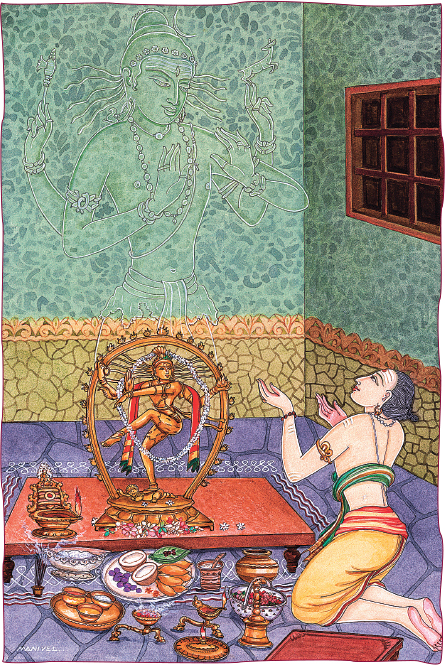
A. MANIVEL
A devotee looks within and beyond the bronze dancing Siva to behold God in His spiritual body of light. Dressed in traditional Hindu garb, the man is performing his daily puja in his home shrine—chanting Sanskrit mantras, offering fruit, water, flowers, incense and light—worshiping devoutly, beseeching God to send blessings through the enshrined image.
6
Are Hindus forbidden to eat meat?
Hindus teach vegetarianism as a way to live with a minimum of hurt to other beings. But in today’s world not all Hindus are vegetarians.
OUR RELIGION DOES NOT LAY DOWN RIGID “DO’S AND don’ts.” There are no commandments. Hinduism gives us the wisdom to make up our own mind on what we put in our body, for it is the only one we have—in this life, at least. Vegetarians are more numerous in the South of India than in the North. This is because of the North’s cooler climactic conditions and past Islamic influence. Priests and religious leaders are definitely vegetarian, so as to maintain a high level of purity and spiritual consciousness to fulfill their responsibilities, and to awaken the refined areas of their nature. Soldiers and law-enforcement officers are generally not vegetarians, because they have to keep alive their aggressive forces in order to perform their work. To practice yoga and be successful in meditation, it is mandatory to be vegetarian. It is a matter of wisdom—the application of knowledge at any given moment. Today, roughly thirty percent of all Hindus are vegetarians.
Elaboration: This can be a touchy subject. There are several ways to respond, depending on who is asking and the background in which he was raised. But the overlying principle that defines the Hindu answer to this query is ahimsa—refraining from injuring, physically, mentally or emotionally, anyone or any living creature. The Hindu who wishes to strictly follow the path of noninjury naturally adopts a vegetarian diet. It’s a matter of conscience more than anything else.
When we eat meat, fish, fowl and eggs, we absorb the vibration of the instinctive creatures into our nerve system. This chemically alters our consciousness and amplifies our lower nature, which is prone to fear, anger, jealousy, confusion, resentment and the like. Many Hindu swamis advise followers to be well-established vegetarians prior to initiation into mantra, and to remain vegetarian thereafter. But most do not insist upon vegetarianism for those not seeking initiation. Swamis have learned that families who are vegetarian have fewer problems than those who are not.
Poignant scriptural citations counsel against eating meat. The Yajur Veda (36.18) calls for kindliness toward all creatures living on the Earth, in the air and in the water. The Tirukural, a 2,200-year-old masterpiece of ethics, states, “When a man realizes that meat is the butchered flesh of another creature, he will abstain from eating it” (257). The Manu Dharma Shastras state, “Having well considered the origin of flesh and the cruelty of fettering and slaying corporeal beings, let one entirely abstain from eating flesh,” and “When the diet is pure, the mind and heart are pure.” For guidance in this and all matters, Hindus also rely on their own guru, community elders, their own conscience and their knowledge of the benefits of abstaining from meat and enjoying a wholesome vegetarian diet. Of course, there are good Hindus who eat meat, and there are not-so-good Hindus who are vegetarians.
Today around the world millions of people are vegetarians because they want to live a long time and be healthy. Many feel a moral obligation to shun the mentality of violence to which meat-eating gives rise. There are good books on vegetarianism, such as Diet for a New America. There is also a fine magazine called Vegetarian Times. The booklet “How to Win an Argument with a Meat-Eater” is online at: www.himalayanacademy.com/view/the-meat-free-life_ei.

A. MANIVEL
Vendors at a market are selling fruits, vegetables, grains, spices and sweets—a potpourri of foods that great cooks creatively combine in one of the world’s most sumptuous cuisines. Hindus understand the sound reasons against eating meat, and many abstain entirely. With such a savory and healthy diet, there is no need to consume flesh.
7
Do Hindus have a Bible?
Our “Bible” is called the Veda. The Veda, which means “wisdom,” is comprised of four ancient and holy scriptures which all Hindus revere as the revealed word of God.
LIKE THE TAOIST TAO TE CHING, THE BUDDHIST DHAMMAPADA, the Sikh Adi Granth, the Jewish Torah, the Christian Bible and the Muslim Koran—the Veda is the Hindu holy book. The four books of the Vedas—Rig, Yajur, Sama and Atharva—include over 100,000 verses. The knowledge imparted by the Vedas ranges from earthy devotion to high philosophy. Their words and wisdom permeate Hindu thought, ritual and meditation.
The Vedas are the ultimate scriptural authority for Hindus. Their oldest portions are said by some to date back as far as 6,000 bce, orally transmitted for most of history and written down in Sanskrit in the last few millennia, making them the world’s longest and most ancient scripture. The Vedas open a rare window into ancient Indian society, proclaiming life’s sacredness and the way to oneness with God.
Elaboration: For untold centuries unto today, the Vedas have remained the sustaining force and authoritative doctrine, guiding followers in ways of worship, duty and enlightenment. The Vedas are the meditative and philosophical focus for millions of monks and a billion seekers. Their stanzas are chanted from memory by priests and laymen daily as liturgy in temple worship and domestic ritual. All Hindus wholeheartedly accept the Vedas, yet each draws selectively, interprets freely and amplifies abundantly. Over time, this tolerant allegiance has woven the varied tapestry of Indian Hindu Dharma.
Each of the four Vedas has four sections: Samhitas (hymn collections), Brahmanas (priestly manuals), Aranyakas (forest treatises) and Upanishads (enlightened discourses). The Samhitas and Brahmanas affirm that God is immanent and transcendent and prescribe ritual worship, mantra and devotional hymns to establish communication with the spiritual worlds. The hymns are invocations to the One Divine and to the Divinities of nature, such as the Sun, the Rain, the Wind, the Fire and the Dawn—as well as prayers for matrimony, progeny, prosperity, concord, protection, domestic rites and more.
The Aranyakas and Upanishads outline the soul’s evolutionary journey, provide yogic philosophical training and propound realization of man’s oneness with God as the destiny of all souls. Today, the Vedas are published in Sanskrit, English, French, German and other languages. But it is the popular, metaphysical Upanishads that have been most amply and ably translated.
The Vedas advise: “Let there be no neglect of Truth. Let there be no neglect of dharma. Let there be no neglect of welfare. Let there be no neglect of prosperity. Let there be no neglect of study and teaching. Let there be no neglect of the duties to the Gods and the ancestors” (Taittiriya Upanishad 1.11.1). “United your resolve, united your hearts, may your spirits be one, that you may long together dwell in unity and concord!” (Rig Veda 10.191.4). “There, where there is no darkness, nor night, nor day, nor being, nor non-being, there is the Auspicious One, alone, absolute and eternal. There is the glorious splendor of that Light from whom in the beginning sprang ancient wisdom” (Shvetashvatara Upanishad 4.18). “Taking as a bow the great weapon of the Upanishad, one should put upon it an arrow sharpened by meditation. Stretching it with a thought directed to the essence of That, penetrate that Imperishable as the mark, my friend” (Mundaka Upanishad 2.2.3).
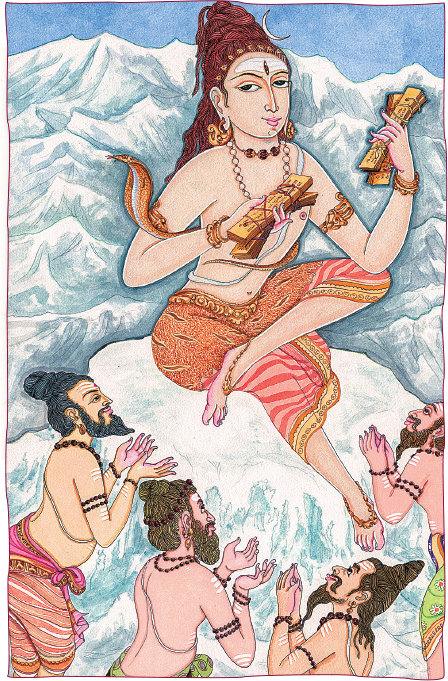
A. MANIVEL
The Vedas are revealed scripture, meaning they were issued forth by God through enlightened sages, or rishis. This divine transmission is depicted here as Lord Siva bestows the four books of the Veda to four rishis. The sacred knowledge, passed orally for most of history, was finally scribed in Sanskrit on palm leaves to share and preserve it.
8
Why do many Hindus wear a dot near the middle of their forehead?
The dot worn on the forehead is a religious symbol. It represents divine sight and shows that one is a Hindu. For women, it is also a beauty mark.
THE DOT WORN BETWEEN THE EYES OR IN THE MIDDLE OF THE forehead is a sign that one is a Hindu. It is called the bindi in the Hindi language, bindu in Sanskrit and pottu in Tamil. In olden days, all Hindu men and women wore these marks, and they both also wore earrings. Today it is the women who are most faithful in wearing the bindi.
The dot has a mystical meaning. It represents the third eye of spiritual sight, which sees things the physical eyes cannot see. Hindus seek to awaken their inner sight through yoga. The forehead dot is a reminder to use and cultivate this spiritual vision to perceive and better understand life’s inner workings—to see things not just physically, but with the “mind’s eye” as well. The bindi is made of red powder (called sindur, traditionally made from powdered turmeric and fresh lime juice), sandalpaste or cosmetics.
In addition to the simple dot, there are many types of forehead marks, known as tilaka in Sanskrit. Each mark represents a particular sect or denomination of our vast religion. We have four major sects: Saivism, Vaishnavism, Shaktism and Smartism. Vaishnava Hindus, for example, wear a v-shaped tilaka made of white clay. Elaborate tilakas are worn by Hindus mainly at religious events, though many wear the simple bindi, indicating they are Hindu, even in the general public. By these marks we know what a person believes, and therefore know how to begin conversations.
For Hindu women, the forehead dot is also a beauty mark, not unlike the black mark European and American women once wore on the cheek. The red bindi is generally a sign of marriage. A black bindi is often worn before marriage to ward off the evil eye. As an exotic fashion statement, the dot’s color complements the color of a lady’s sari. Ornate bindis are even worn by actresses in popular movies and TV shows.
Elaboration: Men and women of a particular religion wishing to identify themselves to one another often do so by wearing distinctive religious symbols. Often these are blessed in their temples, churches or synagogues. Christians wear a cross on a necklace. Jewish boys wear small leather cases that hold scriptural passages, and the round cap called yarmulka. Sikh men wear their hair in a turban. In many countries, Muslim women cover their head with a scarf, called hajib.
Do not be ashamed to wear the bindi on your forehead in the United States, Canada, Europe or any country of the world. Wear it proudly. The forehead dot will distinguish you from all other people as a very special person, a Hindu, a knower of eternal truths. You will never be mistaken as belonging to another nationality or religion. The sacred forehead dot is an easy way of distinguishing Hindus from Muslims. And don’t be intimidated when people ask you what the dot means. Now you have lots of information to give a good answer, which will probably lead to more questions about your venerable religion.
For both boys and girls, men and women, the dot can be small or large depending on the circumstance, but should always be there when appropriate. Naturally, we don’t want to flaunt our religion in the face of others. We observe that many Christian men and women take off or conceal their crosses in the corporate business world. Some communities and institutions disallow wearing religious symbols entirely.
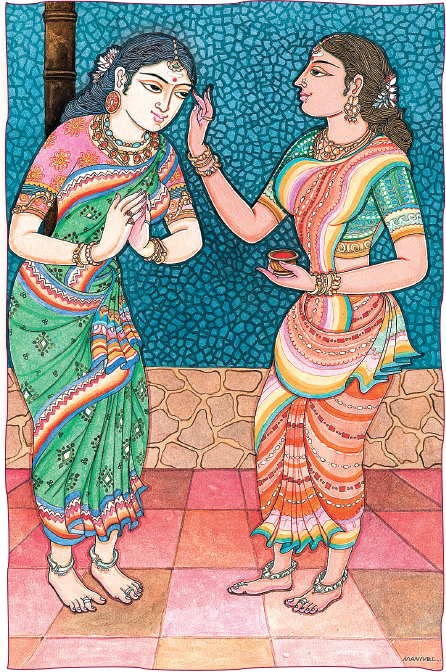
A. MANIVEL
Decorating the face and body with colorful paints is a universal human practice, often a cultural rite expressing one’s tribe, beliefs and identity. The forehead dot shows that one is proud to be a Hindu and bespeaks mystical seeing beyond the five senses. Here, in a simple, daily act, a woman obligingly applies a red bindi to her sister’s forehead.
9
Are the Gods of Hinduism really married?
It is true that God is often depicted with a spouse in our traditional stories. However, on a deeper philosophical level, the Supreme Being and the Gods are neither male nor female and are therefore not married.
IN POPULAR, VILLAGE HINDUISM GOD IS REPRESENTED AS MALE, and God’s energy, or Shakti, is personified as His spouse—for example, Vishnu and Lakshmi. In Hindu temples, art and mythology, God is everywhere seen as the beloved, divine couple. Philosophically, however, the caution is always made that God and God’s energy are One, and the metaphor of the inseparable divine couple serves only to illustrate this Oneness.
Hinduism is taught on many levels to many different people, and to uneducated people who are not able to understand high philosophy, Hinduism is taught in story form. Because the temple is the center of every Hindu community, and everyone is focused on the temple and the Gods within it, the Gods are the major players in these stories. Hindus who understand the higher philosophy seek to find God on the inside while also worshiping God in the temples. Simple folk strive to be like a God, or like a Goddess. These tales, called Puranas, have long been the basis of dance, plays and storytelling around the fire in the homes to children as they are growing up. The stories illustrate how a family should live, how they should raise their children, and much more. Before the printing press, there were few books, and Hinduism was conveyed orally through stories and parables. While these often violent children’s tales should not be perpetuated, there remains much of value in the extensive writings of the Puranas.
Elaboration: Those who learn the higher Hindu philosophies know that Gods are neither male nor female. In fact, attaining to that Godly level of being is one of the mystical goals of yoga. This is accomplished by blending the feminine and masculine currents, ida and pingala, into the spiritual current, sushumna, in the center of the spine within each individual.
Hindus know that the Gods do not marry, that they are complete within themselves. This unity is depicted in the traditional icon of Ardhanarishvara, Siva as half man and half woman, and in the teaching that Siva and Shakti are one, that Shakti is Siva’s energy. Siva is dearly loved as our Father-Mother God. Sexual gender and matrimonial relations are of the physical and emotional realms, whereas the Gods exist in a stratum that far supersedes these levels of life. For that matter, the soul itself is neither male nor female.
Some modern swamis now urge devotees not to pay any attention to Puranic stories about the Gods, saying that they have no relationship with the world today—that they are misleading and confusing and should no longer be taught to the children. Instead, they encourage followers to deepen themselves with the higher philosophies of the Vedic Upanishads and the realizations of Hindu seers.
Other faiths sometimes criticize the Hindu religion as a sort of comic-book religion, and we should not be part of perpetuating that image by passing on such misconceptions as the marriage of the Gods. Other religions move and adjust with the times. Hinduism must also do so. It must offer answers to the questions about God, soul and world—answers that are reasonable, that can be understood and accepted even by a child, that are coherent, sensible and strictly in accord with scripture and tradition. This is necessary in the technological age, necessary in order that Hinduism will be a religion of the future, not of the past.
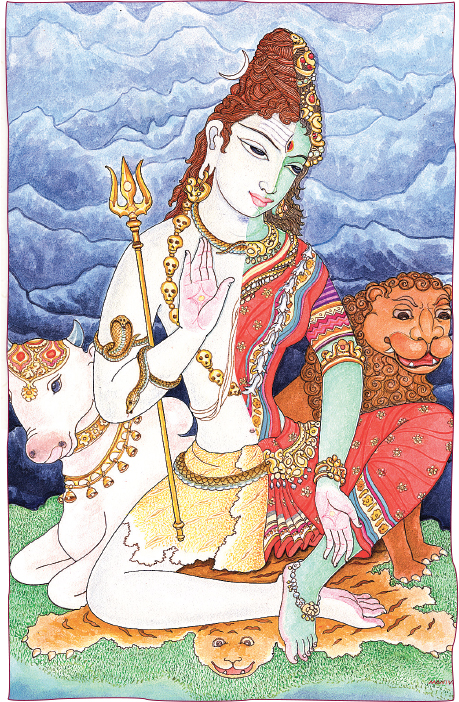
A. MANIVEL
Through history Hindus have depicted God as Ardhanarishvara, which literally means “half-female Lord”—Siva as male on the right and female on the left. This vision of the Divine as our Mother-Father God supersedes the popular, mythological notion of marriage of a God and Goddess, declaring that God and His energy are one.
10
What about caste and untouchability?
Caste is the hereditary division of Indian society based on occupation. The lowest class, deemed untouchables, suffer from discrimination and mistreatment. It is illegal in India to discriminate against, abuse or insult anyone on the basis of caste.
CASTE, FROM THE PORTUGUESE casta, MEANING “CLAN” OR “lineage,” refers to two systems within Hindu society. The first is varna, the division of society into four groups: workers, business people, lawmakers/law enforcers and priests. The second is jati, the thousands of occupational guilds whose members follow a single profession. Jati members usually marry within their own jati and follow traditions associated with their jati. In urban areas they often enter other occupations, but still usually arrange marriages within the jati.
Wealth, especially in urban areas, often trumps caste. Industrialization and education have greatly altered India’s jati system by eliminating or changing the professions upon which it was originally based, and opening new employment options. The jatis are evolving to function today less like guilds and more like large clans of related families. At the bottom are the so-called untouchables, who perform the dirtiest jobs and have suffered much like the black people of America, whose ancestors were freed from slavery in 1865. Strong laws have been passed in India to end caste-based discrimination. Modern Hindus rightly deplore caste abuse and are working to set matters right. Just as in the US, it is a difficult task that will take decades, especially in the villages.
Elaboration: Caste is, no doubt, the biggest stick that Hindus get beaten with. It is taught as the defining attribute, or fatal flaw, of Hinduism in Western schools. Untouchability as a formal system shocks Westerners. One response we can make is to separate social stratification from the issue of racial/class discrimination.
First issue: social stratification. India is one of the world’s oldest societies. It has sustained a continuity of culture and religion for thousands of years. Europe, on the other hand, has seen millennia of upheaval. Still, one only has to go back to before the 17th-century industrial revolution to find a social system that is similar to caste. European society then comprised the landed elite (including royalty, a hereditary caste maintained to this day), merchants, artisans and peasants. The artisans formed guilds, occupation-based organizations that served both as closed unions and marketing monopolies. The guild legacy remains in Western surnames such as Smith, a metal worker. There was no public education system, and each generation learned at home the family occupation. There was little technological change, so jobs were static. Industrialization and public education altered (but did not destroy) this class system in the West, just as they are changing caste and jati in India today.
Second issue: racial/class discrimination. Most Indians are unfamiliar with the extent of discrimination in the West today. In America, for example, hundreds of thousands live destitute and homeless on city streets, as true “untouchables.” US cities are more racially segregated than before the 1950s Civil Rights Movement because of “white flight” to the suburbs. Black Americans receive harsher sentences than white Americans for the same crime. Many Native American Indians live at the bottom of society, destitute and alcoholic, on barren Indian reservations. This kind of response—we can call it the “You’re one, too” defense—doesn’t mean Hindus should not work much harder to end caste discrimination. But it reminds others that no country in the world is yet free from racial discrimination.
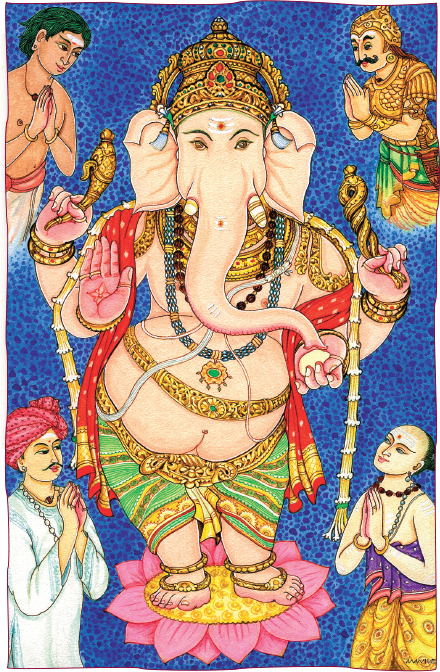
A. MANIVEL
Representatives of the four castes, or varnas, are shown here surrounding Lord Ganesha. They are: worker, businessman, law enforcer and priest. These are natural divisions which appear in all nations and societies as shown by the universal existence, in some form, of labor unions, businessmen’s associations, armies and police forces, and religious ministers.
11
Is yoga a Hindu practice?
Deeply rooted in Hindu scripture and belief, yoga is, and always was, a vital part of Hindu religion and culture. Today it is embraced by tens of millions of non-Hindus seeking its renowned benefits to physical, mental and spiritual health.
IN RECENT YEARS A VIGOROUS DEBATE HAS ARISEN AS TO WHETHer yoga is intrinsically a Hindu practice or a universal science. The word yoga has changed as the practice moved west. Its original meaning, “union with God,” has been replaced with the more secular definition presented by upscale yoga studios around the world that teach a regimen of asanas along with basic breathing and a little meditation. A typical studio ad focuses on the physicality, stating that “yoga increases the circulation of oxygen-rich blood, nourishing and detoxifying the internal organs, musculature, cardiovascular, immune, endocrine, digestive, reproductive and nervous systems.” The United States alone has over 36 million practitioners, and there are hundreds of millions worldwide.
B.K.S. Iyengar, a renowned yoga teacher, gives a more traditional definition on his website: “Yoga is one of the six systems of Indian philosophy. The word yoga originates from the Sanskrit root yuj, which means ‘union.’ On the spiritual plane, it means union of the Individual Self with the Universal Self.”
Elaboration: The term yoga actually refers to a wide range of Hindu practices; so it is important to specify what kind of yoga is being discussed. In common modern usage, yoga typically refers to hatha yoga—the performance of yoga postures, or asanas, which are drawn from ancient Hindu scriptures. Hatha yoga has always been performed by Hindus as a preparation for meditation; today, especially in the West, its health benefits commonly supersede the spiritual. Hatha yoga is just one facet of a broader body of knowledge and practice known as ashtanga yoga, which consists of eight stages. (Ashta means eight; anga means limb). The famous Yoga Sutras of Sage Patanjali, who lived around 200 bce, is considered the first systematic presentation of the ancient tradition of yoga.
To appreciate yoga’s spiritual and religious nature, one need only consider each of its eight limbs, or facets. The first is yama, the ethical restraints; of these, the most important is ahimsa, noninjuriousness. The second is niyama, specific religious observances, including puja in one’s home shrine and repeating mantras. The third is asana, the widely practiced hatha yoga postures. The remaining five limbs are all related to meditation: pranayama (breath control), pratyahara (sense withdrawal), dharana (concentration), dhyana (meditation) and samadhi (illumination, or oneness with God).
Can those of other faiths benefit from the practice of yoga—without threatening their religion’s beliefs? Certainly followers of liberal religious traditions can do so. However, clerics of conservative faith traditions have spoken against its practice for their adherents. For example, in 2008 the leading Islamic council in Malaysia issued an edict prohibiting the country’s Muslims from practicing yoga. Council chairman Abdul Shukor Husim explained: “We are of the view that yoga, which originates in Hinduism… destroys a Muslim’s faith. There are other ways to get exercise. You can go cycling, swimming, etc.”
The Reverend Richard Farr, vicar of Saint Mary’s Church in Henham, England, commented in 2001: “I accept that for some people it is simply an exercise. But it is also often a gateway into other spiritualities, including Eastern mysticism.” The Vatican has issued numerous edicts about the pursuit of yoga. In 1989 it warned that practices like Zen and yoga can “degenerate into a cult of the body” that debases Christian prayer.
It is sometimes argued that yoga is not Hindu per se; only the roots are Hindu. The fact that yoga is pursued by many non-Hindus is irrelevant to its validity as a Hindu practice. The roots of yoga, its scriptural origins, are Hindu. The stem of yoga, its practice, is Hindu; and the flower of yoga, mystical union with God, is Hindu. Yoga, in its full glory, is entirely Hindu. Practice at your own risk!
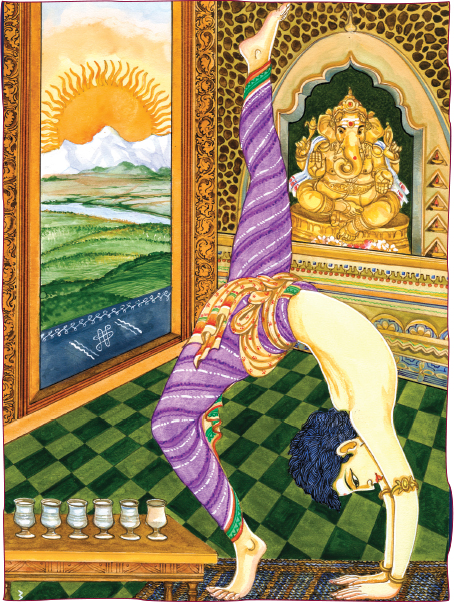
A. MANIVEL
At dawn a devotee practices an advanced hatha yoga asana as part of a series that will prepare him for meditation. Each day in his shrine room, he follows a one-hour spiritual routine of yoga, worship and meditation.
12
How do Hindus view other religions?
Hindus honor all religious traditions and the people within them. While regarding our faith as uniquely endowed, we believe that there is no exclusive path, no one way for all.
IN INDIA, WHERE HINDUS ARE THE OVERWHELMING MAJORITY, the rights of minority religions have always been honored. Hindus have welcomed, embraced and lived peacefully among other religions for centuries. During those same centuries, Hinduism itself evolved into hundreds of strains, and thus Hindus are fully at home with many different traditions and viewpoints within their own faith. Hence, they are naturally tolerant of other religions, respecting the fact that each has unique beliefs, practices, goals and paths of attainment, and not objecting when the doctrines of one conflict with those of another. Hindus readily accept the idea that it is not necessary, desirable or even possible for everyone to hold the same beliefs. And certainly such differences should never be cause for tension, criticism, intolerance or violence.
The ancient Shiva Mahimna Stotram summarizes the Hindu attitude: “As the different streams, having their sources in different places, all mingle their water in the sea, so, O Lord, the different paths which men take through different tendencies, various though they appear, crooked or straight, all lead to Thee.”
Hindus do not proselytize, meaning they do not try to convert members of other faiths to their own. Proselytizing is based upon the belief that one’s religion is the only true religion and everyone else should join it. Hindus hold the view that all faiths are beneficial. A devout Hindu is supportive of all efforts that lead to a pure and virtuous life and would consider it unthinkable to dissuade a sincere devotee from his chosen faith. They know that good citizens and stable societies are created from groups of religious people in all nations. While encouraging others to follow their chosen path with dedication, Hindus hold Sanatana Dharma to be the fullest expression of religion, and do accept sincere souls who seek entrance into Hinduism.
Elaboration: When discussing other religions, Hindu leaders often quote a verse from the Rig Veda (1.164.46): “Ekam Sat, viprah bahudha vadanti,” meaning “Truth is One, sages describe it variously.” It conveys a core Hindu idea: that there can be multiple valid viewpoints about the Supreme. Dr. S. Radhakrishnan, philosopher and former president of India, stressed this point: “The Hindu recognizes one Supreme Spirit, though different names are given to it.”
In expressing religious tolerance, Hindus sometimes cite the above verse to assert that all religions are the same. In reality, all religions are not the same, nor is that indicated by this verse. It simply says that all religions revere the One Truth; all believe in the One Supreme Being. Their beliefs and practices are different; their paths are distinct. Instead of saying, “All religions are the same,” it is better to state that “all religions are good.”
Hindus share values common to all faiths: piety, love of God, respect for tradition, a stress on duty, responsibility and basic human virtues, such as nonviolence, truthfulness, compassion and charity. They know that good citizens and stable societies are created from groups of religious people in all nations. They also acknowledge and honor the many ways that religions differ. For example, meditation and yoga are commonly practiced in Eastern religions but not usually in Western faiths.
The heart of a religion is its understanding of the soul’s relationship to God. Hinduism and most Eastern religions believe that, at the highest level, God and soul are one, inseparable, while Western faiths maintain that Creator and creation are eternally distinct.
Hindus support and participate in ecumenical gatherings with other religions, while upholding their own traditions. They confidently defend their faith, proceed contentedly with their practices and avoid the enchantment of other ways, be they ancient or modern.
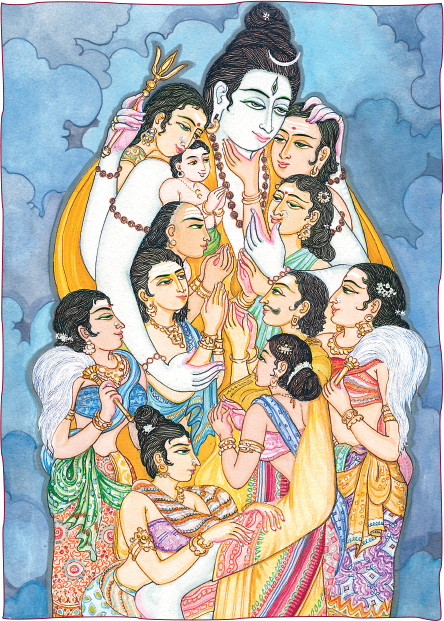
A. MANIVEL
Here the artist depicts the intimate affection between God Siva and humanity. All are embraced, accepted and loved, whatever path they follow, whatever religion they profess.
13
Why do some Hindu Gods have animal features?
In dreams and visions the inner-plane beings have revealed themselves to mankind to be of many forms, expressing many powers. Some appear human, and others, like Ganesha, have animal features.
THE VARIOUS GODS IN HINDUISM’S wide-ranging traditions possess distinct personalities and forms based on how they have been seen in visions and how they are depicted in stories and legends. Hindus feel no need to question the fact, for instance, that Lord Ganesha has the head of an elephant. They know He has been seen in this way by rishis and even by ordinary devotees. Did He choose that form to distinguish Himself as the Lord of Obstacles? No one really knows. The important fact is that millions of Hindus worship and receive blessings from the benevolent Elephant-Faced God every day. Many Hindus seeking an explanation hold that Ganesha is a real being who looks like an elephant. Others believe the elephant form is symbolic. Millions are content with the ancient stories in the Puranas that explain how He came to have an elephant head. Interestingly, and perhaps because of His endearing visage, Ganesha is the most popular of all the Hindu Deities. Numerous other Hindu Divinities have animal attributes, including Hanuman, Varuna, Kamadhenu, the Nagas, the vahanas (animal mounts of the Gods) and four of Vishnu’s ten incarnations (fish, turtle, boar and half-man-half-lion).
Elaboration: An exploration of other ancient faiths shows that Hinduism is not alone in having Divinities with animal attributes. The ancient Greeks worshiped the God Pan, who has the hindquarters, legs and horns of a goat, and the Sea Gods Ichthyocentaurs, with human heads and torsos, the front legs of a horse and the serpentine tails of fish. In Egypt’s pantheon, Anubis (God of the Underworld) is a falcon-headed man, as is Ra (the Sun God). Thoth (Lord of Wisdom and of the Moon) has the head of an ibis or a baboon, and His consort, Bastet, has the form of a cat or a lioness. The Mesoamerican peoples worshiped Quetzalcoatl, a feathered serpent. The Assyrians feared the powerful serpent Goddess Tiamat and revered various winged beings. In Japan—where Buddhism and Shintoism are intertwined—Kitsune the fox and Tengu the bird man are powerful shape-shifters who can transform into human or inanimate shapes to trick humans. Many shrines there are guarded by a pair of magical lion-dogs known as the Koma-inu or Shishi.
In a discussion with Christians, who tend to ridicule Hinduism on this point, you can recall that winged angels are half-human and half-bird. Four-headed beings called the Cherubims were central in the early Christianity. In the Bible’s Book of Revelation, John writes: “I saw a throne standing in heaven; and the One who was sitting on the throne… In the center, grouped around the throne itself, were four animals with many eyes, in front and behind. The first animal was like a lion, the second like a bull, the third animal had a human face, and the fourth animal was like a flying eagle. Each of the four animals had six wings...” (4:1-8). The description matches an account by Jewish prophet Elijah centuries before. Importantly, these beings are the most powerful beings in the pantheon, closest to the Creator.
Over the millennia, worship and awareness of Deities with animal features was eclipsed in most cultures as the monotheistic religions grew into prominence. Were these beings mere myth and imagination, as depicted by modern scholars? Or were the peoples of ancient times aware of a mystical reality that has been sealed off? In most cultures, the old Gods have been put in exile. Only in Hinduism does such worship thrive in unbroken continuity.
One might note the obvious fact that Homo sapiens, too, is an animal species, one among many.
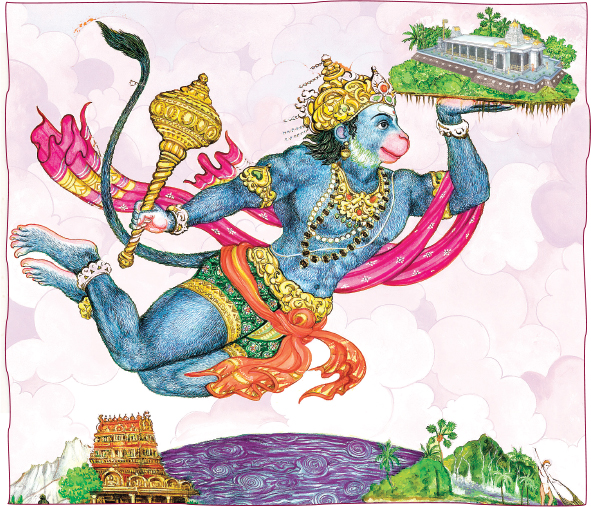
A. MANIVEL
Hanuman carries Iraivan Temple from India to Hawaii. With His monkey body, Hanuman is one of many non-human Deities in the Hindu pantheon. A devotee of Lord Rama, He is regarded as a powerful ally to all on the spiritual path, a symbol of strength and dedication.
14
Why do Hindus cremate the dead?
Hindus arrange swift cremation of the dead, ideally within 24 hours. The fire and accompanying rites sever ties to earthly life and give momentum to the soul for its continuing spiritual journey.
HINDUS TRADITIONALLY CREMATE THEIR dead because a fiery dissolution of the body brings swifter, more complete release of the soul than burial, which preserves the soul’s psychic connection to its just-ended earthly life. After death, the departed soul hovers close to the earth plane in its astral body, emotionally attached to the physical body and its old surroundings, still able to see this material world. The funeral rites and burning of the body signify spiritual release, notifying the soul that, in fact, death has come. Some of the funeral chants address the deceased, urging the soul to relinquish attachments and continue its spiritual journey. The Gods and devas are invoked to assist the soul in its transition. The fire severs ties to earthly life and gives momentum to the soul, granting at least momentary access to refined, heavenly realms. All attention is on a singular goal, as expressed in this prayer from the Rig Veda: “Release him again, O Agni, to the fathers. The one offered to you now proceeds to his destiny. Putting on new life, let him approach the surviving, let him reunite with a [new] body, All-Knowing One!” (10. 16. 5).
Elaboration: Hindus do not believe in bodily resurrection and the reuniting of each soul with its physical body, so they place no importance on preserving the corpse, which is one reason for burial in the Abrahamic religions. The Hindu belief in reincarnation gives assurance that death is merely the soul’s release from the current life. An ancient text puts it simply, “Even as the snake sloughs off its skin, even as the bird leaves its shell, even as in its waking state the soul forgets happenings of the dream state, thus does the soul migrate from one body to another…” (Tirumantiram 2132).
Family and friends take an active part in releasing the departed soul: preparing the body, joining in the rituals, transporting the body to the cremation grounds and lighting the pyre. After cremation, the ashes are ceremoniously committed to a river (often the Ganga), lake or ocean, along with garlands and flowers. While the rites allow family a dignified farewell and an opportunity to express grief, all present know there will be other bodies, other lives. Mourning is never suppressed, but scriptures admonish against excessive lamentation and encourage joyous release. The departed soul feels the impact of emotional forces directed at him, and prolonged grieving can hold him in earthly consciousness, inhibiting full transition to the inner worlds. Hindus speak of death as the Great Departure, regarding it as life’s most exalted moment. The death anniversary is called Liberation Day.
Cremation is prescribed in the Vedic texts, and Hindu funeral customs are remarkably uniform throughout India. Cremation is also practiced by other Indic faiths, Jainism, Sikhism and Buddhism, and is becoming popular worldwide. Many believe the body should be disposed of as swiftly and cleanly as possible and that fire is the purest way to return the physical elements to their source. It is less expensive than burial, with a smaller impact on the environment. Recent figures show that cremations are chosen by 85% in India, 50% in the US, 75% in the UK, 99.9% in Japan, 68% in Canada and 45% in China.
Infants and small children, however, are buried in Hindu tradition. Another exception pertains to enlightened souls, for whom the body is often interred in a crypt filled with salt, and a shrine or temple is constructed at the site. Sacred texts assert their remarkable disciplines have endowed the physical body with immense spiritual power, which can radiate for generations, giving blessings through this sacred samadhi, especially if that soul remains aware of the Earth plane.
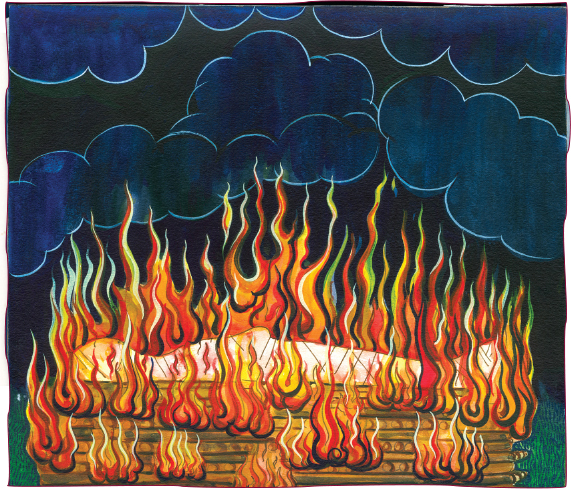
A. MANIVEL
A body, wrapped in cotton cloth, is placed on a funeral pyre made of stacks of wood. Flames return the elements to nature, leaving purified ashes that will be placed in a river or other body of water.
